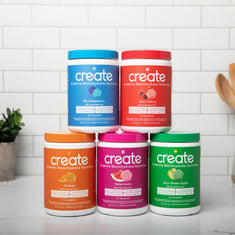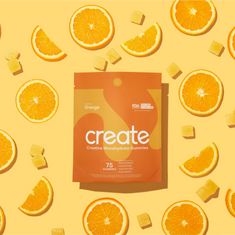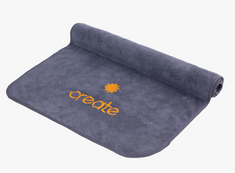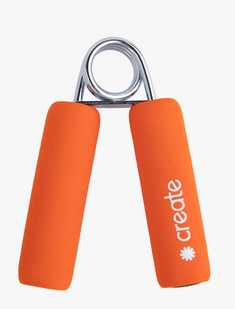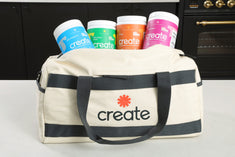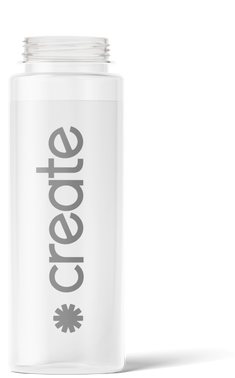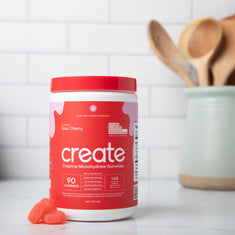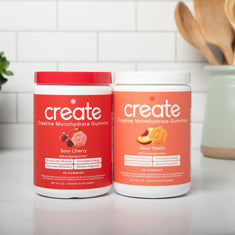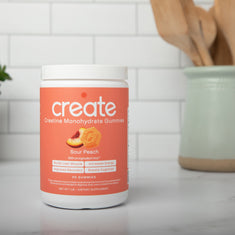Does Creatine Give You A Pump?
The fitness realm is a canvas painted with diverse approaches, supplements, and methodologies, all aiming for the exhilarating sensation of a muscle pump—that feeling of robust, engorged muscles during and after an intense workout. Amid these strategies, a familiar contender stands out: creatine. Renowned for its role in boosting strength, endurance, and muscle growth, creatine has now taken an unexpected turn; countless fitness fanatics now swear by its capacity to promote an intense muscle pump.
Create has harnessed the potential of creatine monohydrate and transformed it into a flavorful and convenient gummy format. As we venture into the intricacies of this relationship, we will explore not only the connection between creatine and the muscle pump but also delve into our best-quality gummies. This journey will illuminate the science behind this pairing, providing a comprehensive view of the evolving landscape of fitness supplementation.
Understanding The Physiological Process Behind The Muscle Pump
The muscle pump is the feeling of tightness and fullness in your muscles during a workout. It typically occurs when you perform multiple sets of an exercise with short rest periods. This happens because your muscles contract to produce force, which causes them to swell with blood and other fluids. The sensation of the muscles pumping can be quite pronounced and is often seen as a sign of an effective workout.
Vasodilation
Vasodilation is essential to muscle pumping. The smooth muscle cells that line blood vessel walls relax during exercise to meet the increased demand for oxygen and nutrients from working muscles. This relaxation expands veins, increasing blood flow. The increased blood flow supplies muscles with more oxygen, nutrients, and hormones than at rest. This enhanced supply is needed for energy synthesis, tissue repair, and muscular performance.
Increased Blood Flow
Vasodilation increases muscle blood flow significantly. Performance and recuperation depend on improved circulation. The increased oxygen delivery supports muscle cells' aerobic metabolism, facilitating energy synthesis without anaerobic pathways. Glucose and amino acid transport increase cellular repair and regeneration. The increased blood flow helps remove energy-production byproducts like carbon dioxide and lactic acid. These waste products must be removed to prevent muscular fatigue and cramping and sustain muscle function.
Nitric Oxide Release
Nitric oxide (NO) serves as a crucial mediator of vasodilation. When the body is subjected to physical activity, particularly resistance or strength training, it triggers the release of nitric oxide. This gas molecule acts as a vasodilator by signaling the smooth muscles around blood vessels to relax. Consequently, blood vessels dilate, accommodating a larger blood volume. The release of NO contributes significantly to the improvement of blood flow to muscles, enhancing nutrient and oxygen delivery while promoting waste product removal.
Muscle Cell Swelling
As blood flow increases due to vasodilation, there is a consequential phenomenon known as muscle cell swelling. The influx of blood and nutrients into the muscle cells leads to a temporary increase in cell volume. This swelling is attributed to the movement of water and ions into the cells. Importantly, muscle cell swelling is closely tied to muscle protein synthesis, the process through which new muscle proteins are created. This temporary increase in cell volume contributes to the sensation of muscle fullness during a workout and has been suggested to play a role in stimulating muscle growth over time.
Stretching Of Fascia
The fascia, a connective tissue that surrounds muscles also contributes to the muscle pump sensation. As blood flow and muscle cell swelling increase, the fascia experiences stretching. This stretching contributes to the feeling of tightness and fullness in the muscles during and after exercise. The fascia's responsiveness to the changes in muscle size and blood flow enhances the overall muscle pump experience, making the muscles feel larger and more engorged.
Psychological And Hormonal Factors
Psychological and hormonal variables affect muscle pumping beyond physiological causes. The feeling of tight, full muscles can boost motivation and training efficacy. Pumps can improve workouts and help people push through tough sessions psychologically. Intense exertion releases adrenaline and growth hormones. These hormones increase heart rate and blood vessel dilation, boosting blood flow. The hormonal reaction increases muscular fullness and tightness, enhancing muscle pump.
Does Creatine Give You A Muscle Pump?
Creatine, a popular supplement and dietary addition among athletes, can, directly and indirectly, impact the muscle pump in the following ways:
Water Retention
Muscle water retention is a real risk while taking creatine supplements. Creatine increases the osmotic potential of muscle cells, which causes the cell to attract water. This causes a short-term increase in muscle size, which helps contribute to satiety. This impact, however, is separate from the "muscle pump" that results from increased blood flow to the muscles The physiologically different pump brought on by increased blood circulation from the water retention effect might contribute to a feeling of muscular fullness.
Indirect Effects
Creatine's principal function is to increase the amount of ATP available for muscular contractions, making them more powerful and lasting. Creatine doesn't directly increase blood flow or dilate blood vessels, but its effects on exercise performance may have a knock-on effect that makes the pump more noticeable. The effects of creatine on ATP allow you to train harder and longer, putting more strain and pressure on your muscles. It's possible that the sense of a "muscle pump" during exercises would be amplified if the stress levels were higher.
Individual Variation
It's important to recognize that individuals respond differently to creatine supplementation. While using creatine, some people may experience a more noticeable muscle pump, but this effect doesn't apply to everyone. Several factors, including genetics, training intensity, and overall physiology, may contribute to this variability.
In some individuals, the water retention effects of creatine may be more pronounced, while in others, the primary reason for an enhanced muscle pump could be the performance gains they experience.
Limited Research
Research on the direct relationship between creatine supplementation and the muscle pump sensation is limited, leaving the connection somewhat uncertain. While there is no clear evidence against a direct link, indirect effects have garnered support from researchers in the field.
One indirect effect of creatine on muscle pumping is evident in the literature. Creatine has been demonstrated to improve muscle glycogen stores by 10% to 20%. When glucose loading is paired with creatine loading, the appearance of muscular growth increases as a result of improved muscle glycogen super-compensation. Muscles seem fuller when glycogen levels increase, adding to the pump experienced after exercise. Additionally, cell volumization and the feeling of a pump in the muscle are influenced by creatine's capacity to promote water retention in muscle cells.
Creatine is popular among bodybuilders because of its extraordinary capacity to increase cell volumization, sometimes known as the muscle pump. An unexpected finding has emerged from recent studies: mixing glycerol and creatine has a synergistic impact that can boost cell volumization to remarkable levels. When glycerol is used, cell volume increases by an astounding 40% compared to when creatine is used alone. The initial increase in plasma volume, which has been called "hyperhydration," dramatically enhances the visual effect of the muscular pump, making the phenomenon all the more remarkable. Insights like these highlight the possibility of utilizing the synergy between creatine and glycerol to achieve a truly amazing and engaging muscle pump.
7 Proven Strategies To Maximize Your Muscle Pump
Maximizing the muscle pump requires a strategic approach that combines various elements, including hydration, nutrition, workout techniques, and supplementation. While creatine alone cannot yield the best results, combining it with other factors like hydration and nutrition contributes to an impressive pump sensation.
Stay Hydrated
Hydration is a vital component of maximizing your muscle pump. Proper hydration helps to ensure that enough blood and water are available for muscular contractions, allowing for larger-than-normal amounts of growth and volumization in the muscles. To stay properly hydrated, it's important to drink plenty of fluids before, during, and after exercise or workouts. Drink at least a liter of water per hour, sipping on it both before and during workouts.
Nutrition
Nutrition, paired with creatine, plays a pivotal role in achieving an exceptional muscle pump. Consuming carbohydrates is crucial as they enhance glycogen stores, fueling energy-demanding workouts. Incorporating foods rich in nitrates, like beetroot, can boost nitric oxide production, improving blood flow and vasodilation and amplifying the pump experience.
Pre-Workout Supplements
Pre-workout supplements, including creatine, offer notable benefits for enhancing the pump. These supplements are believed to bolster blood flow and vasodilation, intensifying the pump sensation. Understanding proper dosages is essential, as they can impact both the pump and overall performance.
High-Rep Training
By using a high-repetition, lightweight training method, metabolic stress is induced, increasing blood flow to the muscles. This method makes use of enhanced circulation to support a stronger pump. Leg extensions and cable flies are two exercises that are good for high-rep training and considerably increase the feeling of a pump.
Supersets And Dropsets
Utilizing strategies like drop sets (dropping weight as you near failure) and supersets (alternating exercises without rest) successfully improves the pump. These techniques increase metabolic stress and blood flow, enhancing the pumping sensation. The pump may be considerably increased by adding movements like bicep curls and tricep extensions to supersets or by using drop sets during chest presses.
Mind-Muscle Connection
The mind-muscle connection is a powerful and overlooked tool to enhance the pump. Focusing on contracting muscles during exercises rather than simply lifting weights can dramatically amplify the pump sensation by bringing more blood to the targeted area. Concentrating on maintaining tension in each rep and controlling time under tension to drive maximum intensity further amplifies this approach.
Ready To Pump Up Your Gains? Try Creatine Now!
It's safe to say that supplementing with creatine can be a fantastic strategy to achieve impressive vascularity and prominent veins during any exercise or weightlifting session. With thoughtful consideration and a solid grasp of its benefits, creatine can become a valuable asset for maximizing your gains as you diligently pursue your performance goals.
Ready to experience the ultimate pumping sensation? Give creatine monohydrate gummies from Create a try and feel the difference immediately. If you're uncertain about the best product for your specific needs, don't hesitate to reach out to us or take our quiz for personalized guidance.
